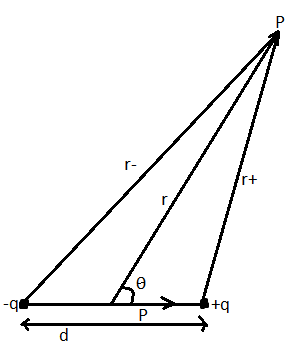
Potential due to an electric dipole is represented by:
(where $p$ is the dipole moment, $r\left( { \gg 2a} \right)$ is the distance at which the potential V of the dipole is calculated and $\theta $ is the angle between the distance vector and the dipole.)
A. $V = \dfrac{{p\cos \theta }}{{4\pi {\varepsilon _0}{r^4}}}$
B. $V = \dfrac{{p\sin \theta }}{{4\pi {\varepsilon _0}{r^2}}}$
C. $V = \dfrac{{p\sin \theta }}{{4\pi {\varepsilon _0}{r^4}}}$
D. $V = \dfrac{{p\cos \theta }}{{4\pi {\varepsilon _0}{r^2}}}$
Answer
564k+ views
Hint: We knew that there are two types of dipole in nature: electric dipole and the magnetic dipole. Magnetic dipole is a closed system while electric dipole is a system made up of two opposite charges separated by small distances. Electric potential experienced by the dipole at any point is the algebraic sum of potential created by both the positive and negative charges.
Complete answer:
Electric potential is the amount of work required for moving a positive unit charge from the infinite to a specific point inside the electric field. So the electric potential at the point which is at the distance $r$ from the point charge $q$ is as given below:
$V = \dfrac{q}{{4\pi {\varepsilon _0}r}}$, where ${\varepsilon _0}$ is the permittivity of the vacuum or free space.
The electric potential is the scalar quantity. For the system of charged particles, electric potential at the point is the sum of all the potential by the charges. So net potential at the point is:
${V_{net}} = \sum\limits_i^{} {{V_i}} $ $ \Rightarrow \dfrac{1}{{4\pi {\varepsilon _0}}}\sum\limits_i^{} {\dfrac{{{q_i}}}{{{r_i}}}} $
So for the electric dipole,

where $p$ is the dipole moment, $r\left( { \gg d} \right)$ is the distance at which the potential V of the dipole is calculated and $\theta $ is the angle between the distance vector and the dipole then,
$V = \dfrac{q}{{4\pi {\varepsilon _0}}}\left( {\dfrac{1}{{{r_ + }}} - \dfrac{1}{{{r_ - }}}} \right) = \dfrac{q}{{4\pi {\varepsilon _0}}}\left( {\dfrac{{{r_ - } - {r_ + }}}{{{r_ + }{r_ - }}}} \right)$
Because point p is very far from the dipole so, we can write the electric potential after solving the above equation as: $V = \dfrac{{p\cos \theta }}{{4\pi {\varepsilon _0}{r^2}}}$ where $p$ dipole moment.
So, the correct answer is “Option D”.
Note:
If the angle between the direction of the dipole to the point at which the electric potential to be calculated is, if $\theta = {90^0}$, then the electric potential at the point is zero and if the angle is $\theta = {0^0}$ then, the electric potential is $V = \dfrac{p}{{4\pi {\varepsilon _0}{r^2}}}$ .
Complete answer:
Electric potential is the amount of work required for moving a positive unit charge from the infinite to a specific point inside the electric field. So the electric potential at the point which is at the distance $r$ from the point charge $q$ is as given below:
$V = \dfrac{q}{{4\pi {\varepsilon _0}r}}$, where ${\varepsilon _0}$ is the permittivity of the vacuum or free space.
The electric potential is the scalar quantity. For the system of charged particles, electric potential at the point is the sum of all the potential by the charges. So net potential at the point is:
${V_{net}} = \sum\limits_i^{} {{V_i}} $ $ \Rightarrow \dfrac{1}{{4\pi {\varepsilon _0}}}\sum\limits_i^{} {\dfrac{{{q_i}}}{{{r_i}}}} $
So for the electric dipole,

where $p$ is the dipole moment, $r\left( { \gg d} \right)$ is the distance at which the potential V of the dipole is calculated and $\theta $ is the angle between the distance vector and the dipole then,
$V = \dfrac{q}{{4\pi {\varepsilon _0}}}\left( {\dfrac{1}{{{r_ + }}} - \dfrac{1}{{{r_ - }}}} \right) = \dfrac{q}{{4\pi {\varepsilon _0}}}\left( {\dfrac{{{r_ - } - {r_ + }}}{{{r_ + }{r_ - }}}} \right)$
Because point p is very far from the dipole so, we can write the electric potential after solving the above equation as: $V = \dfrac{{p\cos \theta }}{{4\pi {\varepsilon _0}{r^2}}}$ where $p$ dipole moment.
So, the correct answer is “Option D”.
Note:
If the angle between the direction of the dipole to the point at which the electric potential to be calculated is, if $\theta = {90^0}$, then the electric potential at the point is zero and if the angle is $\theta = {0^0}$ then, the electric potential is $V = \dfrac{p}{{4\pi {\varepsilon _0}{r^2}}}$ .
Recently Updated Pages
Master Class 12 Business Studies: Engaging Questions & Answers for Success

Master Class 12 Economics: Engaging Questions & Answers for Success

Master Class 12 English: Engaging Questions & Answers for Success

Master Class 12 Maths: Engaging Questions & Answers for Success

Master Class 12 Social Science: Engaging Questions & Answers for Success

Master Class 12 Chemistry: Engaging Questions & Answers for Success

Trending doubts
What are the major means of transport Explain each class 12 social science CBSE

Which are the Top 10 Largest Countries of the World?

Draw a labelled sketch of the human eye class 12 physics CBSE

How much time does it take to bleed after eating p class 12 biology CBSE

Explain sex determination in humans with line diag class 12 biology CBSE

Differentiate between homogeneous and heterogeneous class 12 chemistry CBSE




